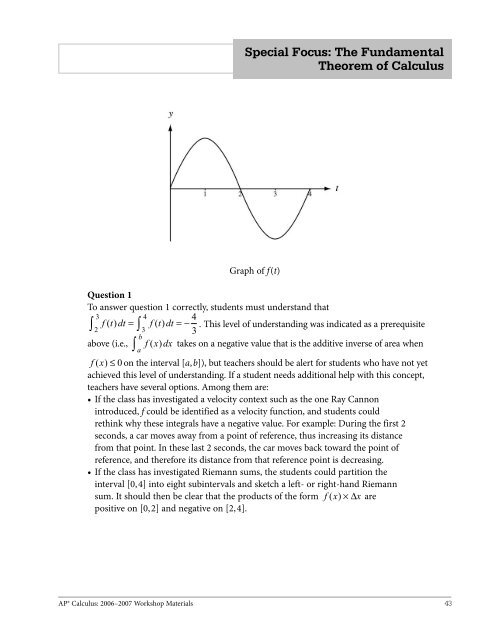AP Calculus
Calculus_SF_Theorem
Calculus_SF_Theorem
You also want an ePaper? Increase the reach of your titles
YUMPU automatically turns print PDFs into web optimized ePapers that Google loves.
Special Focus: The Fundamental<br />
Theorem of <strong>Calculus</strong><br />
Graph of f(t)<br />
Question 1<br />
To answer question 1 correctly, students must understand that<br />
∫<br />
3<br />
∫<br />
4 4<br />
f ( t) dt = f ( t)<br />
dt = − . This level of understanding was indicated as a prerequisite<br />
2<br />
3 3<br />
b<br />
above (i.e., ∫ f ( x)<br />
dx takes on a negative value that is the additive inverse of area when<br />
a<br />
f ( x) ≤ 0 on the interval [a,b]), but teachers should be alert for students who have not yet<br />
achieved this level of understanding. If a student needs additional help with this concept,<br />
teachers have several options. Among them are:<br />
• If the class has investigated a velocity context such as the one Ray Cannon<br />
introduced, f could be identified as a velocity function, and students could<br />
rethink why these integrals have a negative value. For example: During the first 2<br />
seconds, a car moves away from a point of reference, thus increasing its distance<br />
from that point. In these last 2 seconds, the car moves back toward the point of<br />
reference, and therefore its distance from that reference point is decreasing.<br />
• If the class has investigated Riemann sums, the students could partition the<br />
interval [0,4] into eight subintervals and sketch a left- or right-hand Riemann<br />
sum. It should then be clear that the products of the form f ( x) × ∆ x are<br />
positive on [0,2] and negative on [2,4].<br />
<strong>AP</strong>® <strong>Calculus</strong>: 2006–2007 Workshop Materials 43


